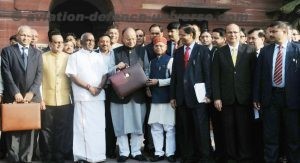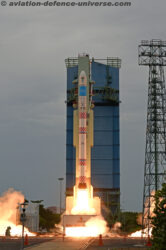
Arun Jaitley, Finance Minister , India : “A number of initiatives have been taken to develop and nurture intrinsic defence production capability to make the nation self-reliant for meeting our defence needs. Ensuring adequate budgetary support will be our priority.”
Nirmala Sitharaman, Defence Minister, India : “These are the first ever Defence Production Corridors being formed in the country. These Defence Industry Corridors will give a big boost to defence production in the country. This shall provide impetus to the defence production industry in the country and in the region, in particular. ”
Shobana Kamineni, President, CII: “The Budget provides impetus to the sectors of agriculture and rural economy with many significant measures which will add to overall consumption and demand and boost growth. The support to MSME sector through lowering of the corporate tax rate to 25%, increase in access to finance, and addressing non-performing assets would help alleviate the stress in the sector.”
Rashesh Shah, President, FICCI : “It will drive consumption in a big way, thus helping growth in other related sectors. Additionally, the attention to the MSMEs through better access to finance or lowering of the corporate tax rate would also help spur both employment and growth in this vital segment of the economy. The stress on jobs in the Budget will help generate meaningful employment going ahead. Additionally, the attention to the MSMEs through better access to finance or lowering of the corporate tax rate would also help spur both employment and growth in this vital segment of the economy.”
Sandeep Jajodia, President, ASSOCHAM :“The budget is on expected lines and provides support to sections of the society, where it was needed the most. The FM and the Prime Minister Narendra Modi know how to put the money where the mouth is. The agri and rural landscape were in some kind of distress and provision of over Rs 14.34 lakh crore to be spent on rural infrastructure should also add to the employment generation especially in the farm sector. This money would come from non-budgetary sources. Relief to the salaried employees by way of Rs 40,000 per annum would leave more disposable income in the hands of the middle class and boost consumer demand. ”
Amitabh Khosla, Country Director – India, International Air Transport Association (IATA) : “We welcome the focus on airport infrastructure capacity announced in the Budget. In our 20 year passenger forecasts, IATA anticipates India will become the 3rd largest aviation market by 2024. But this is by no means guaranteed. To make this a reality, airport capacity in India needs to be augmented and expanded quickly. IATA has earlier recommended and is supportive of leveraging AAI’s balance sheet for infrastructure creation and expansion. But the big question mark on capacity, and a critical area of concern for IATA , continues to be about Mumbai airport. Navi Mumbai airport is still a distant dream. In the meantime, Mumbai continues to fall behind in aviation activity, and Maharashtra state is unable to maximize the economic potential that can be delivered by aviation. We urge the government to urgently look at innovative approaches to bridge the infrastructure shortfall.”
Vasant Subramanyan, National President, Indo-American Chamber of Commerce : “ The finance minister has deftly handled the Union Budget priorities by assigning equal importance to development priorities and people-centric programs. Even some of the Budget proposals, which can be termed as populist, have their strong economic and development connect.”
Amber Dubey, Partner & Head, Aerospace and Defence, KPMG in India : “Encouraging to see the FM talk about increasing airport capacity to handle 1 billion trips per annum from around 180 million currently. KPMG has always believed that India could surprise the world and become the largest aviation market by 2030. It’s fantastic to see that the govt is shifting from short term planning to a long term vision. The focus should now shifts to the execution of this challenging yet achievable vision. Since most of the aviation policy matters have been covered under National Civil Aviation Policy (NCAP 2016), no major policy decisions were expected in the budget. The industry wants jet fuel to be included under GST regime and GST relief for the struggling MRO and General Aviation sectors. These fall under the domain of the GST Council and will be taken up there. The government’s focus on improving infrastructure at leading tourist spots is positive. This will help grow aviation too. Overall a positive budget for aviation. The fight for GST relief on jet fuel, MRO and General Aviation will have to taken up with the GST Council.”
Dhiraj Mathur, Leader – Aerospace and Defence, PwC India : “The defence budget for 2018-19 has seen a marginal increase of 5.8% over the last year and accounts for 10.74% of the total allocation. We are happy to note that the growth in allocation and share of capital expenditure exceeds that of revenue. This was our pre-budget ask/expectation. Moreover, it reverses a five year trend of decreasing capital budgets. The announcement of a new defence production policy and two defence industrial production corridors is welcome. However, it is not clear how they will be setup as there appears to be no budgetary allocation. It is also heartening to note that MoD has been able to spend its allocation last year.”
Pierre de Bausset, President and Managing Director, Airbus India : “The budget has sought to strike a balance between India’s need for economic growth and the well being of its citizens. Investments to improve people’s health, education and skill development are vital for long-term growth prospects of a country, and the budget has rightly focused on them. It addresses the aspirations of a modernising nation through initiatives to expand air connectivity under the UDAN scheme. The government has also announced measures to push its ‘Make in India’ programme, including plans for two Defence Industrial Corridors and a new industry- friendly Defence Production Policy in 2018. We hope such steps will foster a sustainable eco-system that promotes investment and helps expedite the modernisation of the armed forces in a constantly evolving strategic environment.”
Ankur Gupta, Vice President, HEMRO : “It is encouraging to see through the available data that the MoD has spent its entire allocation for modernization. We hope that this trend continues in the years to come. Although the Capital budget has seen an increase, it may still fall short to meet the requirements generated from the large modernization programs. It is also about time that some emphasis is laid upon the maintenance and sustenance of existing assets. This is another area where the the OEMs coupled with domestic firms can play a significant role. ” (Given in individual Capacity)
Puneet Kaura, Managing Director & CEO, Samtel Avionics Ltd.: “Modernisation of defence forces and setting up of Industrial Corridors for Defence are the two key takeaways from this budget for the defence industry. What remains to be seen how much SOPs or tax benefits these industrial corridors bring to the private industry, and contribute to ease of doing business. The hike of 7.6% in defence budget will translate to 20% if we exclude pensions – but how much of it goes to Capex is actually what the industry is looking at.”
Kabir Bogra, Partner, Khaitan & Co.: “The budget is a mixed bag for the defence sector. While the announcement of establishment of defence industrial corridors and the defence production policy would bolster manufacturing and benefit MSMEs, the increase of spending by about 8% to 2,95,511 crores implies that the focus continues to remain in addressing existing revenue expenditure requirements rather than allocation of capital for acquisition of new equipment. The modernization process seems to have taken a backseat this year.”
































































































































